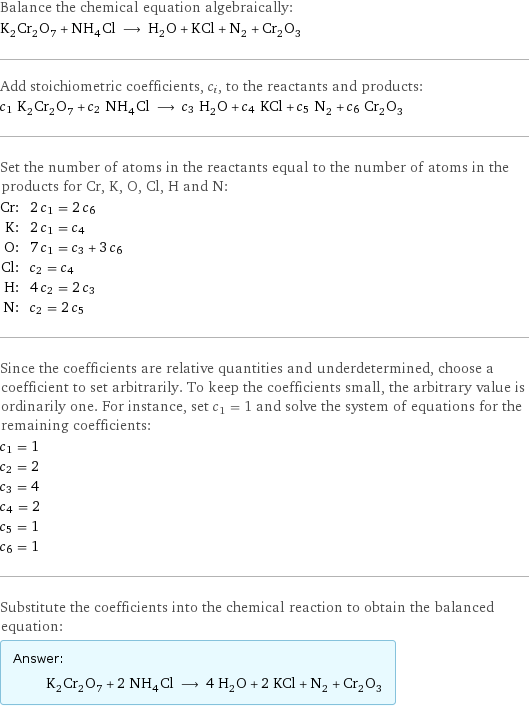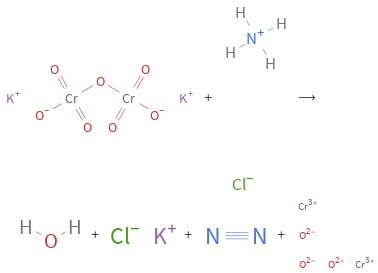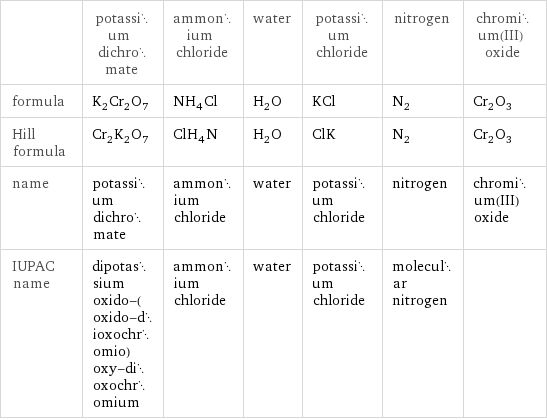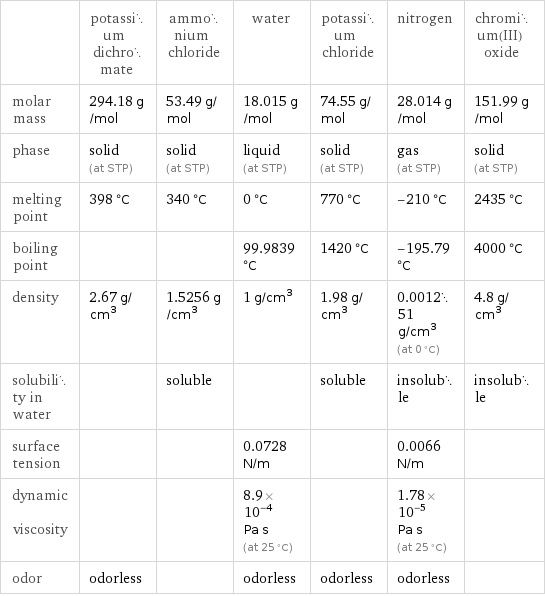Input interpretation

K_2Cr_2O_7 potassium dichromate + NH_4Cl ammonium chloride ⟶ H_2O water + KCl potassium chloride + N_2 nitrogen + Cr_2O_3 chromium(III) oxide
Balanced equation

Balance the chemical equation algebraically: K_2Cr_2O_7 + NH_4Cl ⟶ H_2O + KCl + N_2 + Cr_2O_3 Add stoichiometric coefficients, c_i, to the reactants and products: c_1 K_2Cr_2O_7 + c_2 NH_4Cl ⟶ c_3 H_2O + c_4 KCl + c_5 N_2 + c_6 Cr_2O_3 Set the number of atoms in the reactants equal to the number of atoms in the products for Cr, K, O, Cl, H and N: Cr: | 2 c_1 = 2 c_6 K: | 2 c_1 = c_4 O: | 7 c_1 = c_3 + 3 c_6 Cl: | c_2 = c_4 H: | 4 c_2 = 2 c_3 N: | c_2 = 2 c_5 Since the coefficients are relative quantities and underdetermined, choose a coefficient to set arbitrarily. To keep the coefficients small, the arbitrary value is ordinarily one. For instance, set c_1 = 1 and solve the system of equations for the remaining coefficients: c_1 = 1 c_2 = 2 c_3 = 4 c_4 = 2 c_5 = 1 c_6 = 1 Substitute the coefficients into the chemical reaction to obtain the balanced equation: Answer: | | K_2Cr_2O_7 + 2 NH_4Cl ⟶ 4 H_2O + 2 KCl + N_2 + Cr_2O_3
Structures

+ ⟶ + + +
Names

potassium dichromate + ammonium chloride ⟶ water + potassium chloride + nitrogen + chromium(III) oxide
Equilibrium constant
![Construct the equilibrium constant, K, expression for: K_2Cr_2O_7 + NH_4Cl ⟶ H_2O + KCl + N_2 + Cr_2O_3 Plan: • Balance the chemical equation. • Determine the stoichiometric numbers. • Assemble the activity expression for each chemical species. • Use the activity expressions to build the equilibrium constant expression. Write the balanced chemical equation: K_2Cr_2O_7 + 2 NH_4Cl ⟶ 4 H_2O + 2 KCl + N_2 + Cr_2O_3 Assign stoichiometric numbers, ν_i, using the stoichiometric coefficients, c_i, from the balanced chemical equation in the following manner: ν_i = -c_i for reactants and ν_i = c_i for products: chemical species | c_i | ν_i K_2Cr_2O_7 | 1 | -1 NH_4Cl | 2 | -2 H_2O | 4 | 4 KCl | 2 | 2 N_2 | 1 | 1 Cr_2O_3 | 1 | 1 Assemble the activity expressions accounting for the state of matter and ν_i: chemical species | c_i | ν_i | activity expression K_2Cr_2O_7 | 1 | -1 | ([K2Cr2O7])^(-1) NH_4Cl | 2 | -2 | ([NH4Cl])^(-2) H_2O | 4 | 4 | ([H2O])^4 KCl | 2 | 2 | ([KCl])^2 N_2 | 1 | 1 | [N2] Cr_2O_3 | 1 | 1 | [Cr2O3] The equilibrium constant symbol in the concentration basis is: K_c Mulitply the activity expressions to arrive at the K_c expression: Answer: | | K_c = ([K2Cr2O7])^(-1) ([NH4Cl])^(-2) ([H2O])^4 ([KCl])^2 [N2] [Cr2O3] = (([H2O])^4 ([KCl])^2 [N2] [Cr2O3])/([K2Cr2O7] ([NH4Cl])^2)](../image_source/260288dd16b29fbacbba436c47a21916.png)
Construct the equilibrium constant, K, expression for: K_2Cr_2O_7 + NH_4Cl ⟶ H_2O + KCl + N_2 + Cr_2O_3 Plan: • Balance the chemical equation. • Determine the stoichiometric numbers. • Assemble the activity expression for each chemical species. • Use the activity expressions to build the equilibrium constant expression. Write the balanced chemical equation: K_2Cr_2O_7 + 2 NH_4Cl ⟶ 4 H_2O + 2 KCl + N_2 + Cr_2O_3 Assign stoichiometric numbers, ν_i, using the stoichiometric coefficients, c_i, from the balanced chemical equation in the following manner: ν_i = -c_i for reactants and ν_i = c_i for products: chemical species | c_i | ν_i K_2Cr_2O_7 | 1 | -1 NH_4Cl | 2 | -2 H_2O | 4 | 4 KCl | 2 | 2 N_2 | 1 | 1 Cr_2O_3 | 1 | 1 Assemble the activity expressions accounting for the state of matter and ν_i: chemical species | c_i | ν_i | activity expression K_2Cr_2O_7 | 1 | -1 | ([K2Cr2O7])^(-1) NH_4Cl | 2 | -2 | ([NH4Cl])^(-2) H_2O | 4 | 4 | ([H2O])^4 KCl | 2 | 2 | ([KCl])^2 N_2 | 1 | 1 | [N2] Cr_2O_3 | 1 | 1 | [Cr2O3] The equilibrium constant symbol in the concentration basis is: K_c Mulitply the activity expressions to arrive at the K_c expression: Answer: | | K_c = ([K2Cr2O7])^(-1) ([NH4Cl])^(-2) ([H2O])^4 ([KCl])^2 [N2] [Cr2O3] = (([H2O])^4 ([KCl])^2 [N2] [Cr2O3])/([K2Cr2O7] ([NH4Cl])^2)
Rate of reaction
![Construct the rate of reaction expression for: K_2Cr_2O_7 + NH_4Cl ⟶ H_2O + KCl + N_2 + Cr_2O_3 Plan: • Balance the chemical equation. • Determine the stoichiometric numbers. • Assemble the rate term for each chemical species. • Write the rate of reaction expression. Write the balanced chemical equation: K_2Cr_2O_7 + 2 NH_4Cl ⟶ 4 H_2O + 2 KCl + N_2 + Cr_2O_3 Assign stoichiometric numbers, ν_i, using the stoichiometric coefficients, c_i, from the balanced chemical equation in the following manner: ν_i = -c_i for reactants and ν_i = c_i for products: chemical species | c_i | ν_i K_2Cr_2O_7 | 1 | -1 NH_4Cl | 2 | -2 H_2O | 4 | 4 KCl | 2 | 2 N_2 | 1 | 1 Cr_2O_3 | 1 | 1 The rate term for each chemical species, B_i, is 1/ν_i(Δ[B_i])/(Δt) where [B_i] is the amount concentration and t is time: chemical species | c_i | ν_i | rate term K_2Cr_2O_7 | 1 | -1 | -(Δ[K2Cr2O7])/(Δt) NH_4Cl | 2 | -2 | -1/2 (Δ[NH4Cl])/(Δt) H_2O | 4 | 4 | 1/4 (Δ[H2O])/(Δt) KCl | 2 | 2 | 1/2 (Δ[KCl])/(Δt) N_2 | 1 | 1 | (Δ[N2])/(Δt) Cr_2O_3 | 1 | 1 | (Δ[Cr2O3])/(Δt) (for infinitesimal rate of change, replace Δ with d) Set the rate terms equal to each other to arrive at the rate expression: Answer: | | rate = -(Δ[K2Cr2O7])/(Δt) = -1/2 (Δ[NH4Cl])/(Δt) = 1/4 (Δ[H2O])/(Δt) = 1/2 (Δ[KCl])/(Δt) = (Δ[N2])/(Δt) = (Δ[Cr2O3])/(Δt) (assuming constant volume and no accumulation of intermediates or side products)](../image_source/a17672dee34493880db86cdf6423f35a.png)
Construct the rate of reaction expression for: K_2Cr_2O_7 + NH_4Cl ⟶ H_2O + KCl + N_2 + Cr_2O_3 Plan: • Balance the chemical equation. • Determine the stoichiometric numbers. • Assemble the rate term for each chemical species. • Write the rate of reaction expression. Write the balanced chemical equation: K_2Cr_2O_7 + 2 NH_4Cl ⟶ 4 H_2O + 2 KCl + N_2 + Cr_2O_3 Assign stoichiometric numbers, ν_i, using the stoichiometric coefficients, c_i, from the balanced chemical equation in the following manner: ν_i = -c_i for reactants and ν_i = c_i for products: chemical species | c_i | ν_i K_2Cr_2O_7 | 1 | -1 NH_4Cl | 2 | -2 H_2O | 4 | 4 KCl | 2 | 2 N_2 | 1 | 1 Cr_2O_3 | 1 | 1 The rate term for each chemical species, B_i, is 1/ν_i(Δ[B_i])/(Δt) where [B_i] is the amount concentration and t is time: chemical species | c_i | ν_i | rate term K_2Cr_2O_7 | 1 | -1 | -(Δ[K2Cr2O7])/(Δt) NH_4Cl | 2 | -2 | -1/2 (Δ[NH4Cl])/(Δt) H_2O | 4 | 4 | 1/4 (Δ[H2O])/(Δt) KCl | 2 | 2 | 1/2 (Δ[KCl])/(Δt) N_2 | 1 | 1 | (Δ[N2])/(Δt) Cr_2O_3 | 1 | 1 | (Δ[Cr2O3])/(Δt) (for infinitesimal rate of change, replace Δ with d) Set the rate terms equal to each other to arrive at the rate expression: Answer: | | rate = -(Δ[K2Cr2O7])/(Δt) = -1/2 (Δ[NH4Cl])/(Δt) = 1/4 (Δ[H2O])/(Δt) = 1/2 (Δ[KCl])/(Δt) = (Δ[N2])/(Δt) = (Δ[Cr2O3])/(Δt) (assuming constant volume and no accumulation of intermediates or side products)
Chemical names and formulas

| potassium dichromate | ammonium chloride | water | potassium chloride | nitrogen | chromium(III) oxide formula | K_2Cr_2O_7 | NH_4Cl | H_2O | KCl | N_2 | Cr_2O_3 Hill formula | Cr_2K_2O_7 | ClH_4N | H_2O | ClK | N_2 | Cr_2O_3 name | potassium dichromate | ammonium chloride | water | potassium chloride | nitrogen | chromium(III) oxide IUPAC name | dipotassium oxido-(oxido-dioxochromio)oxy-dioxochromium | ammonium chloride | water | potassium chloride | molecular nitrogen |
Substance properties

| potassium dichromate | ammonium chloride | water | potassium chloride | nitrogen | chromium(III) oxide molar mass | 294.18 g/mol | 53.49 g/mol | 18.015 g/mol | 74.55 g/mol | 28.014 g/mol | 151.99 g/mol phase | solid (at STP) | solid (at STP) | liquid (at STP) | solid (at STP) | gas (at STP) | solid (at STP) melting point | 398 °C | 340 °C | 0 °C | 770 °C | -210 °C | 2435 °C boiling point | | | 99.9839 °C | 1420 °C | -195.79 °C | 4000 °C density | 2.67 g/cm^3 | 1.5256 g/cm^3 | 1 g/cm^3 | 1.98 g/cm^3 | 0.001251 g/cm^3 (at 0 °C) | 4.8 g/cm^3 solubility in water | | soluble | | soluble | insoluble | insoluble surface tension | | | 0.0728 N/m | | 0.0066 N/m | dynamic viscosity | | | 8.9×10^-4 Pa s (at 25 °C) | | 1.78×10^-5 Pa s (at 25 °C) | odor | odorless | | odorless | odorless | odorless |
Units
